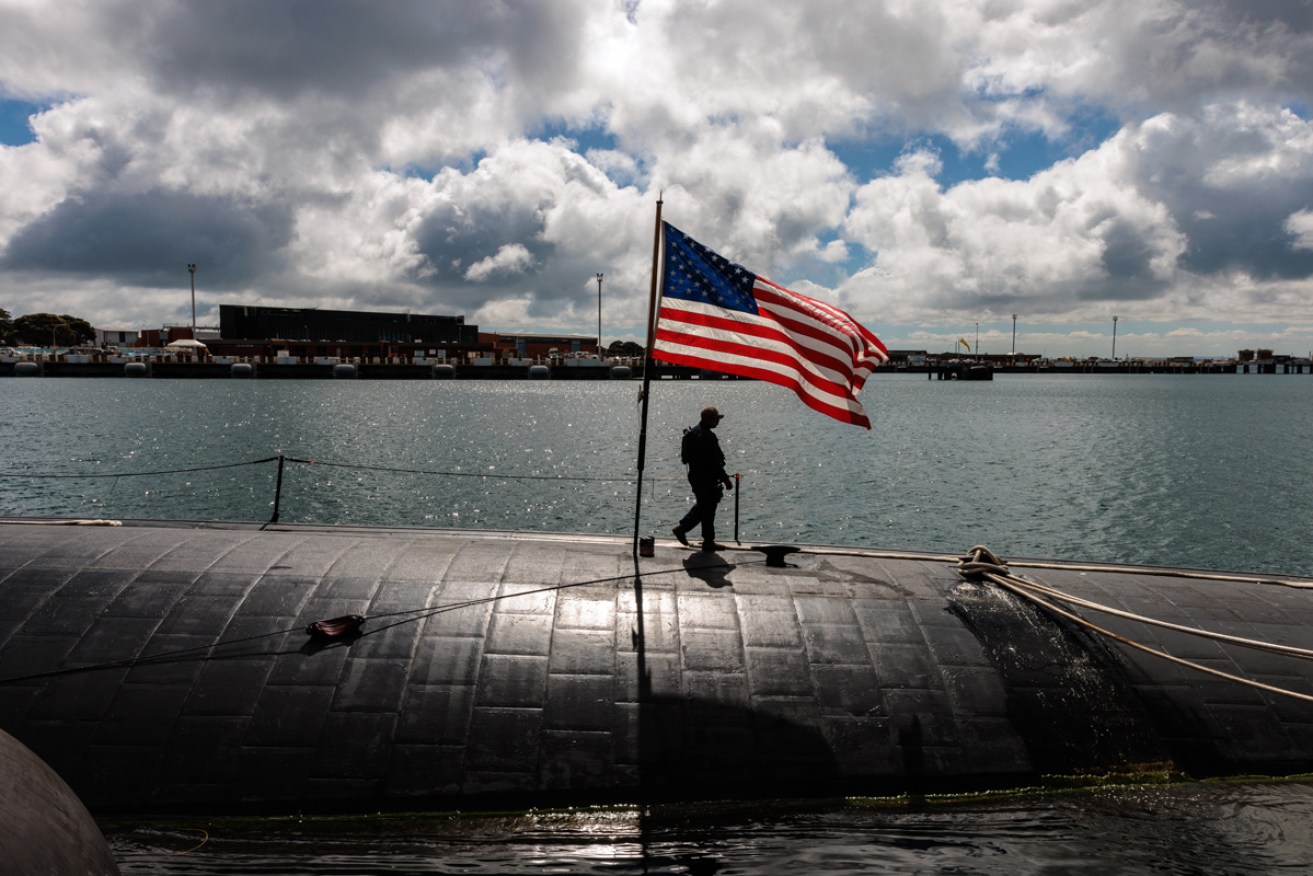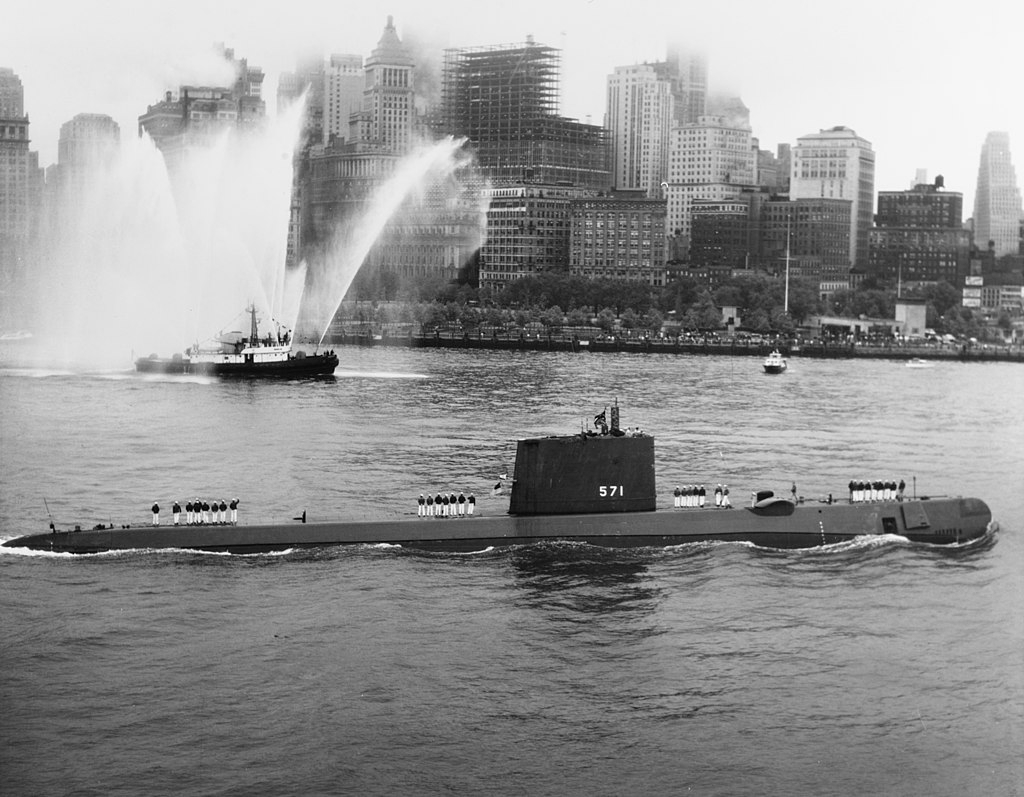Facts submerged amid nuclear subs spin
The super-powered hype of the AUKUS announcement shrouds some uncomfortable realities for South Australia, argues Matthew Abraham.


The US says it will build only one Virginia-class a year until at least 2028, despite the AUKUS deal agreement to supply Australia with at least three from 2032. Photo: AAP/Richard Wainwright
It took America two years to build the USS Nautilus, the world’s first operational nuclear-powered submarine.
The keel of Nautilus, or SSN-571, was formally laid by President Harry S. Truman on June 14, 1952. She was launched 18 months later and commissioned for duty in September 1954. Before long she was at sea, becoming the first sub to navigate under the North Pole.
That’s less time than it’s taking us to complete the upgrade of the Cross and Fullarton roads intersection, faster than the still-unfinished duplication of the Joy Baluch Bridge in Port Augusta and a shorter new vehicle waiting time than placing an order today for a hybrid Toyota Rav4.
Westinghouse was given the job of designing and knocking up a nuclear propulsion plant for the sub on the last day of 1947, meaning they had it fired up in less time than it took South Australia to decide trams couldn’t turn right on North Terrace. Just saying.
It’s going to be 20 years before the first Australian-made nuclear submarine is built in Adelaide’s Osborne shipyards. Twenty years.
That’s if it ever happens, and this remains a very big “if”.
Obviously, the modern nuclear submarine has a few more bells and whistles than the Nautilus, but even so, it’s hard to get your head around the blurry timelines, wishful thinking, bombast, spin and jingoism surrounding Australia’s headlong dive into a nuclear submarine future.
A breathless nation learned on Tuesday that Australia will spend up to a mind-boggling $368 billion to beg, borrow, buy and maybe build a fleet of nuclear-powered submarines over the next three decades under the AUKUS security pact with the US and Britain.
Adelaide was promised it would get to build them all. It won’t.
We’ll get jobs and a big $2 billion shed out of the deal to start with, but make no mistake, South Australia has been seriously dudded by the Albanese Government, and the Morrison Government before it.

The USS Nautilus entering New York harbor on 25 August 1958, after her voyage under the North Pole. Photo: US Navy, Public domain, via Wikimedia Commons
Let’s start with a few facts, hard to decipher amid the flurry of media releases and news grabs.
As a stop-gap measure, Australia will acquire three, pre-loved US Virginia-class nuclear submarines, plus an option to buy two more, with the first not due to arrive until 2033.
Democratic US Congressman Joe Courtney, chair of the Seapower and Projection Forces sub-committee of Congress, assures us the second-hand Virginia-class subs will be of the highest quality.
“No one is going to be foisting off clunkers on good friends and allies,” he told the ABC’s Insiders.
This was meant to be reassuring, but it raised the question of whether there’s such a thing as a “clunker” nuclear sub – ones with three-on-the-tree column shifts, drum brakes and wind-down periscopes?
The first of eight new joint British-Australian-designed nuclear-powered subs, dubbed the SSN-AUKUS class, is planned to be delivered from Osborne in 2042.
InDaily reports that four American nuclear-powered submarines and one UK vessel “will begin rotating through Western Australian naval bases from as early as 2027 to boost Australia’s ability to operate its own vessels in the 2030s and 2040s”.
The political and media hype over Tuesday’s announcement isn’t just extraordinary. It’s become ridiculous.
It leaves South Australia once again chasing rainbows in a sadly familiar pattern.
Premier Peter Malinauskas must or should be privately fuming about the fact that under the fast-tracked AUKUS subs plan, no subs are scheduled to be built in Adelaide until 2042 at the earliest.
Publicly, his sales pitch goes like this:
“The fact that the Commonwealth sees in South Australia the ability to build the most complex machines that have ever been produced in the history of humanity says a lot about where South Australia is going.”
Oh, come on. More complex than the Large Hadron Collider, the world’s largest and most powerful particle accelerator, consisting of a 27-kilometre ring of superconducting magnets in a tunnel under the France-Switzerland border?
It is exploring “the basic laws governing the interactions and forces among the elementary objects, the deep structure of space and time, and in particular the interrelation between quantum mechanics and general relativity”.
Still, how can a machine exploring the origins of the universe hope to compete with the complexity of an AUKUS submarine? It’s just a big Meccano set, really.
While the champagne corks were popping here and on both sides of the Atlantic, I’m not drinking the Kool-Aid on a deal that has more leaks than an open torpedo tube.
It leaves South Australia once again chasing rainbows in a sadly familiar pattern.
Any deal can come unstuck with a change of government, a change of economic fortunes and, most particularly in the US, a change of President.
With a snap of the fingers, the Morrison Government scrapped the $90 billion deal with the French to build 12 conventional attack-class submarines at Osborne.
Taxpayers shelled out a $136 million settlement to the French Naval group, part of the $3.4 billion wasted on the dumped project.
Already, US and Australian defence hard-heads are questioning the lunacy of Australia planning to float two different sets of boats – the US Virginia class and the yet-to-be-designed, uncosted British SSN-AUKUS class subs.
Wouldn’t it be simpler, and cheaper, to keep buying the Yank subs? It’s a good question and one that will be asked louder and louder as the years roll on and the costs blow out.
The AUKUS pact was hatched in trademark, paranoid secrecy by former Prime Minister Scott Morrison, and he’s proud not even his closest Cabinet colleagues knew what he was up to.
They’re not the only ones. The Australian public not only didn’t know, but have had absolutely no say in whether we should be leaping into the nuclear bathtub.
Former Prime Minister Paul Keating delivered a scathing take-down of the AUKUS pact in an address to the National Press Club, calling it the “worst international decision” by a Labor government since conscription in World War I.
“For $360 billion, we’re going to get eight submarines,” he said. “It must be the worst deal in all history.”
Even putting aside Keating’s epic spray, Australia’s sudden embrace of nuclear submarines has many unsettling and unanswered questions.
If we are going to build and operate nuclear submarines, why are we so shy about arming them with nuclear weapons?
If we are going to allow US and British nuclear submarines to rotate through WA naval bases from 2027, are we really going to insist they leave their most potent deterrent hardware – nuclear missiles – in the sock drawer at home?
Surely arming Australian nuclear subs with nuclear missiles is the next logical step and you can bet it’s one our defence chiefs have already turned their minds to, behind closed doors.
How and where will we dispose of the high-level radioactive waste from our nuclear subs?
Defence Minister Richard Marles said this week the waste would be housed on “defence land” owned by the Commonwealth.
Woomera in our Far North is Commonwealth defence land that includes Maralinga, comprehensively nuked and left contaminated by British atmospheric atom bomb tests between 1956 and 1963 – a legacy of our last nuclear cuddle with the Brits.
Could that be the “defence land” he has in mind?
Nuclear fuel and reactors have a nasty habit of overstaying their welcome.
The prototype nuclear reactor built for the USS Nautilus in 1952 – known as the Submarine 1st generation Westinghouse, or S1W, prototype – wasn’t shut down until 1989. It’s due to be deactivated and decommissioned this year by the US Department of Energy.
Still, the USS Nautilus – now a naval museum – sounds like a good old tub.
She had the same name as Captain Nemo’s fictional submarine in Jules Verne’s 1870 science fiction novel Twenty Thousand Leagues Under the Sea.
Her patch, or insignia, was designed especially for the sub by Walt Disney’s art department.
The Disney touch is apt, because dipping our nation’s toes in a nuclear warfare future feels like the beginning of an adventure in Fantasyland.
Matthew Abraham’s weekly analysis of local politics is published on Fridays.
Matthew can be found on Twitter as @kevcorduroy. It’s a long story.




